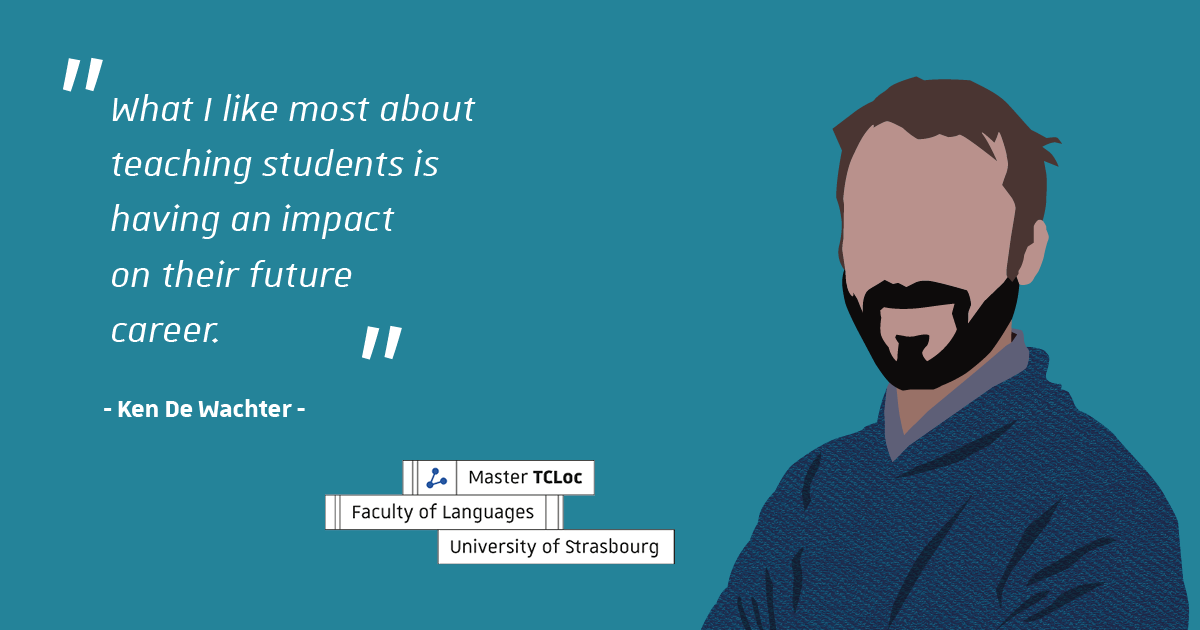Meet Ken De Wachter, the professional translator, technical writer, and trainer who will be instructing TCLoc students on how to use MadCap Software products. His experience with studying, teaching, and working in translation and technical communication makes him the perfect choice for our extracurricular course on one of the leading tools in the industry.
In addition to the required teaching units in the curriculum, TCLoc students sometimes have the opportunity to follow extracurricular courses as well. These are optional courses that the program offers simply to provide students with more knowledge and skills. Teaching such a course is Ken De Wachter, owner of the consulting company Flynxo and professional in technical writing and translation. He has joined the TCLoc community to introduce our students to the most important tools from MadCap Software, a leading resource for authoring and publishing solutions for technical writers and translators. Before the start of his course, we were able to schedule a meeting with Ken to get a sneak peek. He kindly shared not only a glimpse of what he’ll be teaching but also what his professional journey has been like and what he’s up to today.
Meeting Ken De Wachter
It’s always exciting to have a new instructor join the community. Welcome, Ken! What motivated you to give this training on Madcap Software tools?
My contacts at MadCap told me that you were looking for a teacher and asked me if I wanted to be introduced. Of course I did! I’ve been teaching at the University of Leuven for ten years — mainly CAT tools, but these last years I’ve also taught terminology and technical writing. I also train professional translators and technical writers in companies. I love the contrast between those two profiles. Professionals know exactly what they want to achieve and care less about the rest. Students have a broader interest and learn at an incredible speed, but they often have less insight in real-life applications and business value. What I like most about teaching students is having an impact on their future career. I regularly run into alumni, and they often impress me with the way they implement the things we did in class. I secretly prefer teaching students, though the industry pays better. A good balance between the two is ideal.
Obviously, when I learned more about the TCLoc master’s degree program, my enthusiasm grew even more. As a translator and a technical writer, I’ve always been a strong advocate of interconnecting these two fields. This hybrid master is doing exactly that, and I’m really honored to be a part of it.
The Journey to Translation and Technical Writing
Well, it’s so great to have you. Tell me about how you got involved in technical communication and translation. How did you get where you are today? Where did you start?
During the final semester of my master’s degree in translation at the University of Leuven, I started thinking seriously about what would come next. I realized that I loved languages, but I didn’t really know how to make a living off that. Translating seemed like too much of a solo activity; it also implied that I would have to become a freelancer. That scared me a lot.
At that point, I was writing my master’s thesis under the supervision of Prof. Frieda Steurs, one of the leading ladies in the field of terminology. She put me on the track of specialized language and terminology and showed me its economic opportunities and business value, which helped me envision my professional future. So, I enrolled in a postgraduate programme about language technology and computational linguistics. After graduating, I got recruited by the university and worked on a variety of projects — all of which revolved around terminology and translation quality.
And how did you like that kind of work?
At the start, I loved that job. I got to travel all over Europe, see its most beautiful cities and work with incredible people. It made me a true European citizen. However, after five years, the high pressure and work pace caught up with me. I had just gotten married and was tired of being away from home so often. So, I cut back my hours at the university and got a part-time job in an ICT company as a technical writer. To be honest, I thought that it was going to be boring to write user documentation, but I actually enjoy it a lot. ICT is a fun domain to work in. Being a tech-savvy linguist amongst developers is great because I have a completely different skill set.
You’ve continued combining jobs in these fields ever since, it seems. Why does this appeal to you and what are some of your current projects?
I’ve always been too restless for a traditional nine-to-five, but I want the stability of a fixed income. The combination of working part time as an in-house technical writer and having my own little consultancy company, Flynxo, gives me the best of both worlds.
My regular job is at Collibra, a fast-growing company that develops software for data management. It’s an agile environment with monthly releases. Quite a challenge for the documentation! We write our user documentation in MadCap Flare, with GitHub as our versioning tool. Our workload depends a lot on the engineering teams. I’m constantly in touch with different development teams to discuss new and updated features. I keep a lot of plates spinning, so I have to split up my work into tasks, then prioritize and plan them. Having freedom and responsibility really keeps the work interesting. Some weeks, the developers deliver a lot of new features, so I can only document the most urgent things. Other weeks, developers do more backend work that doesn’t affect end users directly, so I can do in-depth research and document business cases and best practices.
I also enjoy having little adventures on my own, so I founded Flynxo. In the beginning, I mostly worked with terminology and translation technology. Later, I expanded into authoring technology. Mainly, I give training on SDL Trados Studio, Memsource and MadCap Flare.
In the past 10 years, I think I’ve seen every kind of organization in Europe and every domain. I’ve worked with “typical” translation agencies and freelance translators, but also with government agencies, a wide range of in-company translation departments and even the army.
Other domains I’ve worked with include automotive, healthcare, pharmaceutical, finance, energy, ICT, transport, e-commerce and heavy industry — each with their own particularities and requirements.
My favorite project is helping Translators without Borders (TWB) set up a terminology workflow. After a humanitarian crisis such as a hurricane, crisis response teams from all over the world go on site to help. One of the challenges is often communication; TWB provides linguistic services. We’re now working on a project to manage crisis and COVID-19 terminology, translate it into many languages of lesser diffusion, and disseminate it amongst translators and interpreters.
The Role of MadCap Software
You have quite a variety of professional interests! Although you’re certainly qualified to teach many subjects related to our curriculum, you’re providing our students with training on MadCap Software tools. What’s so great about MadCap Flare and how does it relate to technical communication?
Flare is MadCap’s flagship. It’s an all-inclusive authoring suite with powerful single-sourcing capabilities. You write content in a relatively easy editor and combine those pieces of content into a concrete target. You write it once, but you can reuse the content as often as you need. You can also tag content if you want to create different user guides from the same content. That allows you to create tailored user guides for specific companies or user types.
For example, imagine you need user guides in PDF and HTML for starters as well as advanced users. Your product may also have different licensing types and optional modules. Some customers may have specific requirements and custom features. You’d need dozens of user guides with a lot of overlapping content. In theory, it’s possible to do that in MS Word. In practice, it would be impossible to keep all the documentation consistent and harmonized.
Every change in your product, big or small, requires updates to the documentation. You don’t want to dig into dozens of Word files trying to find the relevant sections. You want a central repository of content in which you can make the required changes. Our company releases product updates almost every two weeks, so we need to follow the development cycles closely.
That’s where Flare shines. For each user guide, we have a “target” defined in the software and the target knows which content is relevant for its guide. So, we simply update the content in the central repository and move on. All relevant user guides will be updated automatically.
MadCap Flare and Other Documentation Software
Wow, that is amazingly efficient. But how does Flare compare with other technical writing solutions? What are some similarities and differences?
In the category of complete authoring suites, the biggest competitor of MadCap Flare is Adobe RoboHelp. The tools are a bit similar. Although Flare is the younger of the two, it quickly took a large piece of the market. Obviously, it’s also a matter of personal preference, but I think Flare is easier to use and more complete.
Some of the biggest competitors of Flare aren’t really proper authoring tools: MS Word and wikis such as Confluence. I often compare it with sleeping on the couch. It works, but it’s not comfortable and gives you a pain in the neck. Typically, Word and Confluence are used by companies that don’t really want to invest in proper documentation.
Then there’s DITA. DITA is not a software application, but an XML architecture that was designed for documentation. You can author the DITA XML files in any XML editor, such as Oxygen and XMetal, or even Notepad++. You can create the actual output files by importing the DITA XML files into a publishing tool such as Adobe InDesign or FrameMaker. Though I like some of the features, DITA is too complicated for most companies.
Finally, there are markup languages such as Markdown and Asciidoc. Just like with DITA, they’re not software applications, but they provide markup to write documentation. Also similar to DITA, they have some very good features, but user-friendliness is not one of them.
MadCap Software and the Industry
Tools and technologies are constantly evolving and being updated. What are some of the ways MadCap Software has affected or been affected by the technical communication industry?
MadCap is growing fast and has made it easier for companies to publish attractive documentation. This creates a lot of awareness of the importance of user documentation. They also evangelize topic-based authoring very efficiently. They also really excel in building community — there’s an interesting blog section on their website, a Slack community, and my favorite conference of the year: MadWorld.
If you work in a company, it’s easy to get stuck in your ways and routines. MadCap really succeeded in connecting technical writers across companies and industries. After all, technical writers in other companies face similar challenges. By reaching out to them, you can see how they solve problems and learn from them. Or, alternatively, you can help them.
A great example of this is the use of interactive elements in user documentation. Three years ago, we didn’t use any dropdown selectors or buttons in our user guides. Then, during a session at MadWorld, a speaker showed some examples of them and shared a simple JavaScript to make it possible. My colleagues and I started using it at Collibra, and some of our developers improved the JavaScript further. Obviously, we shared the upgraded version with others. So, the MadCap community gave something to us, we used and improved it and then gave it back to the community. Everybody wins.
TCLoc and MadCap Software
This idea of community is definitely a value shared by the TCLoc master’s program as well. What information and insights will you be sharing with our students during your course?
Simplistically formulated: students will learn the most important features of MadCap Flare. They will be able to create a documentation project from scratch, edit the content and publish it in HTML and PDF. Obviously, we’ll cover a lot of tips, tricks and best practices. Realistic, hands-on materials will show both the advantages and the limitations of single-sourcing. Students will do some real writing and content structuring. We might even throw in some JavaScript to make the content interactive!
The goal is to have students go beyond the “simple use” of Flare and come out of this course as fully independent users!
It sounds like it will be a great course! We’re so excited to provide access to this software and training to our students. Thank you for taking the time to do this interview and for lending your knowledge and experience to our program!
Are you familiar with MadCap Software products? Which one is your favorite and what do you use it for? Let us know in the comments! Also, if you are a TCLoc student or alumni, contact us to see if you are eligible to receive licenses to access MadCap Software products and other software tools.



